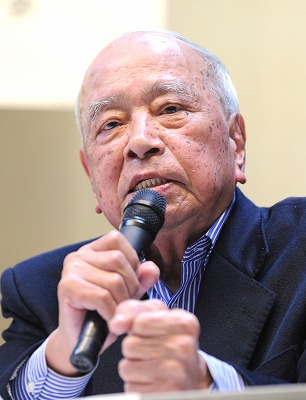Former Okinawa Governor and Battle of Okinawa scholar Masahide Ota passes away

Former Okinawa Governor Masahide Ota passed away at age 92.
June 12, 2017 Ryukyu Shimpo
Former Okinawa Governor Masahide Ota died at age 92 due to respiratory failure and pneumonia at a hospital in Naha City at 11:50 a.m. on June 12.
He experienced the raging battle of Okinawa as a member of “Tekketsu Kinnotai” or “Blood and Iron Student Corps”. He served as Okinawa Governor and as a member of the Upper House, and was dedicated to solving the military base issue and developing the prefectural economy.
Ota was borne in 1925 in Kumejima Island. In 1945, he was drafted into the 32nd Japanese Imperial Army as a member of Tekketsu Kinnotai when he was a second-year student at Okinawa Shihan Gakko, a normal school or teachers’ college, and barely escaped death.
After graduating from Waseda University, he studied in the United States, and later became a member of the Golden Gate Club, which consisted of Okinawans who had participated in study-abroad programs in the U.S.
In 1968, he worked as a professor at the University of the Ryukyus, majoring in Media Sociology and conducted research into news media reports.
In 1990, Ota ran in the prefectural gubernatorial election as the unified candidate of the reformists and moderates, and defeated Junji Nishime, incumbent conservative candidate. He recaptured the prefectural administration for the reformists for the first time in 12 years.
Governors of the past have been asked what is “Okinawa no kokoro”, the heart of Okinawa. Ota expressed the view that it was the “symbiosis of loving peace”.
In 1995 during his term of office, he built the Cornerstone of Peace and the Okinawa Prefectural Archives, and started relocating and renovating the Peace Memorial Museum.
In 1996, he drew up the “international city formation initiative”, a future vision of Okinawa with no military bases, aiming to ensure self-sustaining development.
In addition, he created an action program to return all lands used by U.S. forces in stages, and proposed it to the central government.
The idea of the international city formation initiative is being carried on in the current Okinawa promotion plan “Okinawa 21st Century Vision”.
Regarding the U.S. base issue, Ota visited the United States seven times, more visits than any previous governor, seeking to reduce the U.S. base burden.
In 1995, an okinawan girl was raped by U.S. service members.
The then-governor Ota refused to sign the contracts to renew the land leases for military use on behalf of the landowners who rejected their contracts, and he was sued by the prime minister.
After he was defeated by Keiichi Inamine in the 1998 governor’s election, he ran as a candidate of the Social Democratic Party in the Upper House election in 2001 and was elected.
He retired from politics in 2007.
Ota was also known as a scholar who specialized in researching the Battle of Okinawa and the U.S. High Commissioners, who governed Okinawa. He revealed the reality of the Battle of Okinawa and the subsequent era of the U.S. military rule from the viewpoint of residents.
Ota wrote over seventy books, including “Okinawa – War and Peace”, “Ugly Japanese – How the General Public Sees Okinawa”, “The bottom of Okinawans’ heart
The Battle of Okinawa and me
“, “The Corner stone of Peace”, “This Was The Battle of Okinawa”, “Chronological Coverage of the Battle of Okinawar”and “Public Consensus in Okinawa”.
He received the Higashionna Kanjun Prize for remarkable achievement in Okinawan studies in 1998, and the Ryukyu Shimpo Award in 2009. In 2017, he was nominated as a candidate for the Nobel Peace Prize.
(English translation by T&CT)
Previous Article:Osprey from Futenma Air Station makes emergency landing at Ie Jima Auxiliary Airfield
Next Article:MV-22 Osprey belonging to Futenma base makes emergency landing at Amami Airport without advance notification.
[Similar Articles]
- Anti-US base candidates win all seats in Okinawa in Lower House election
- Base-Opposing Takara wins House of Councillors Election, bolstering the momentum of Okinawa’s anti-base contingent
- Tomohiro Yara wins Okinawa No. 3 district Lower House by-election with platform opposing new Henoko base
- Former Governor Ota opens an exhibition hall on the Battle of Okinawa – “War is Ugly” is his message
- Leader opposing move to Henoko wins 3rd term in House of Councillors election
 Webcam(Kokusai Street)
Webcam(Kokusai Street)


